When Sonia Terk married Robert Delaunay in 1910, she was 25. She had already changed her country twice, her name twice, and been married once, a brief marriage of convenience to Wilhelm Uhde, art critic and collector. He was homosexual; she was under social pressure from her family in Russia. Being married gave her an excuse to stay in Paris. Uhde remained a lifelong friend, but in the artist Delaunay, a pioneer of abstraction, she found a soulmate. Together, they became quite the avant-garde power couple.
Born Sarah Stern in Ukraine, Sonia had been sent at a young age to live with her uncle and aunt in St Petersburg. They were highly cultivated, well-to-do Jews, and Sonia adopted their surname. She altered her first name, too, and as Sonia Terk set off to study painting in Germany. At 21, she made her way to Paris in search of freedom, vitality and youth – which she found. A photograph from 1908 shows her seated at a table in a dark, fussy dress, all buttons and pleats (albeit with bare forearms). She is already looking middle-aged. A photo taken five years later shows Sonia posing in a loose patchwork outfit of her own creation, made in dynamic, contrasting “simultané” style. She appears years younger, and ready to dance.
The first works in the Tate Modern’s forthcoming show are from Sonia’s pre-Paris youth. They are oil-on-canvas portraits and landscapes, which owe much to Gauguin, with colours that leap from the walls. This early fascination with colour would determine the rest of her long career. The figurative element duly fell away (although it would reappear from time to time) and soon she was producing vibrant abstracts. Her aunt in St Petersburg had died bequeathing her property, and Robert was a minor aristocrat, so the Delaunays enjoyed a private income. Together they entertained and held salons. Among their friends were artists such as Kandinsky and Chagall, and the poets Guillaume Apollinaire and Blaise Cendrars.
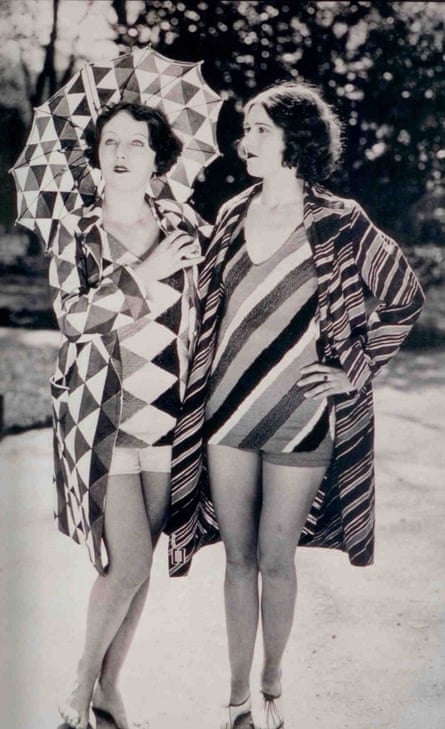
In this case, the pram in the hall was not the enemy of promise. (In any case, surely poverty is the more likely candidate.) It is still rare, however, for a cradle cover to be given gallery space and acknowledged as an important artwork. The little blanket Sonia stitched for her son, Charles, in 1911 is to be exhibited, and it seems to have been a breakthrough piece which moved her from figurative work to abstract. The coverlet is a patchwork medley of pinks, creams and greens with hints of maroon and black. It shows how Sonia melded Russian folk-craft with Parisian avant garde, and anticipated the experiments with colour and shape that would become the Delaunay hallmark style, simultané.
As well as the baby quilt, there is on display the child’s painted toy box, and the outfit Sonia made in the same manner, the one in the photograph mentioned above: by 1913 the Delaunays had found a babysitter and were setting off to the dancehall, the Bal Bullier. As well as making clothing for herself and her friends, Sonia still painted. Next to the dress, which is composed of swatches of fabric in different textures, is her large canvas Bal Bullier. A flow of colour and rhythm, it shows several couples (or one couple twirling) under a new Parisian sensation: coloured electric lights.
It’s possible Sonia steered herself away from painting to give Robert space to pursue his, so they could work alongside each other on their mutual project without coming into direct competition. Sonia chose to work increasingly in needlework. She was happy to emphasise her Russian background (though not her Jewishness), as the Russian folk arts were fashionable and undergoing a revival. It may also have been that Sonia and other modernists saw no distinction between fine art and applied art. She was after all a cross‑cultural polyglot, accustomed to translating and changing modes of expression. Why shouldn’t her aesthetic manifest itself now as a painting on a wall, now as a dress, now as a book-binding? Her art was wearable, it was the lifestyle statement of a new breed: the creative modern woman.
Thus simultané, which Sonia and Robert were to practise all their lives, came into being. What was it? A movement, a style, an aesthetic adventure? (Cendrars called it a “technique”.) A Russian-French fusion, it rejoiced in the movement and contrast of colours and their loquacity. It relished the dynamic created when this colour or shade was parked next to that, and perceived at once, simultaneously. In Sonia’s work, there is lively movement and rhythm. (“Contrast is love,” said Cendrars.) Colour was language. Every sound had its hue.
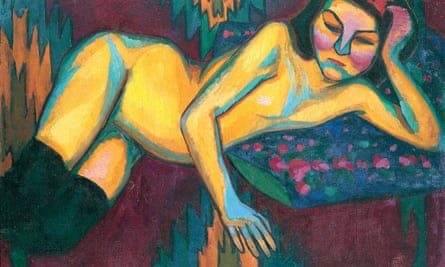
Cendrars was another cross-cultural polyglot, and soon he and Sonia were collaborating on a book, La prose du Transsibérien et de la Petite Jehanne de France (1913). A glorious two metres long by 20cm wide, folded concertina-like into a hand-painted sleeve, the work presents Cendrars’s travel poem on the right in differently coloured fonts, and Delaunay’s tumbling artwork on the left “interpreting through colours and their shades the themes and feelings expressed by the poetic text”. A triumph of synaesthesia, it hears the poem’s sounds as colour, its rhythms as shapes. At the bottom is a little red Eiffel Tower, a motif that appeared over and over again in the work of both Robert and Sonia Delaunay, as the dernier cri in modernity.
This couple at the centre of avant-garde Paris, champions of each other, were on holiday in Spain at the outbreak of the first world war. There they remained until later moving to Portugal. They painted and exhibited and formed contacts that would stand them in good stead. Sonia again produced large canvases, which are as far from the mud of Flanders as can be imagined. Emerging from her unmistakable arcs and bows are market scenes and flamenco singers.
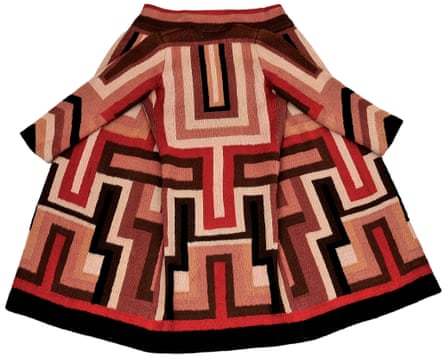
If it was a charmed life, the Russian revolution put a brief halt to it. Sonia relied on letting her properties in St Petersburg, but in 1917 the Bolsheviks seized them and the flow of money stopped. It must have been a shock. In their 30s, for the first time the Delaunays had to find a way to make a living. With her needlework and design skills, Sonia was better placed than the more delicate Robert. In Madrid, the couple had met Diaghilev, and soon Sonia was designing costumes for the Ballets Russes’ Cleopatre. The move into commerce was a mere shimmy for the simultané aesthetic. Never backwards in coming forwards, by the mid-1920s Sonia had a Paris studio dedicated to creating textiles and clothing, and she opened a fashion house called simply Sonia. The once avant-garde experiment was proving its worth, with the word simultané registered as a brand name in France and the US.
The central decades of this retrospective are suggestive of an upmarket shopping experience. Boutique windows are recreated with embroidered shoes and bags arranged as Sonia herself decreed. Her fabrics are displayed on mechanical moving rollers for full dynamic effect. There are fabric samples, risque bathing costumes and driving caps for modern girls who drove the newfangled motor cars. It may have been modern, but it was artisanal and expensive, of course.
If Sonia’s main aesthetic changed little over decades, and what began as a radical exploration of colour contrasts became a fashionable brand, is it art? Or design? Or, indeed, both at once – simultané? Here was painting enacted, sensualised. It was performance art brought to us by fashion models. Sonia attracted wealthy clients: a woollen embroidered coat was made in 1925 for the movie star Gloria Swanson, in geometric shades of rich spicy reds, browns and creams. In these fashion creations, straight lines predominate as diamonds and stripes and straight-edged lines turn at right angles. It’s as if the excitement of the whirling ballroom has been supplanted by the glamour of the road. But not for long: in the 1930s the curves and wheels and arcs were very much back.
For four more decades Sonia designed fabrics for the Amsterdam luxury store Metz and Co, and latterly for Liberty. She didn’t abandon the poets, it must be said. A “poem-curtain” of the time has verses by the surrealist Philippe Soupault embroidered in wool. She made “poem-dresses” – words that walked – and lectured at the Sorbonne on “the influence of painting on clothing design”.
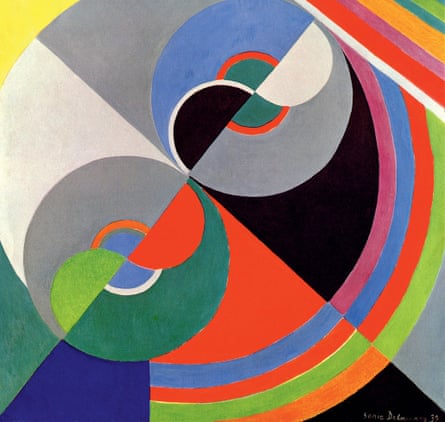
Sonia’s life kept pace with the century. Simultané was devised at the dawn of the modern world, its works hand-painted and hand-stitched. By the 1930s she was aware of the possibilities of mass – and machine – production. She said: “In this way, fashion will become democratic, and this … can only be welcome, as it will raise general standards.” One wonders what she would have made of shops such as Zara, or H&M.
When the second world war broke out and Paris was occupied, Sonia’s Jewishness suddenly became relevant. It’s said that her son, Charles, a noted promoter and critic of jazz who joined the resistance during the war, didn’t know that his mother was Jewish until very late in the day. In 1940, the Delaunays quit Paris and moved south, but by this time Robert was ill. He died in 1941. He had painted constantly, and exhibited widely while supporting his wife in her ventures as she extolled his. She championed his legacy after his death by organising retrospective exhibitions and making gifts of his work, seeking to secure his reputation as one of the great pioneers of abstraction. With Robert gone, Sonia turned to painting in oil and gouache. The tones are more muted, more grainy, less bright and freewheeling than La Prose du Transsibérien, with semi-circles arranged along diagonal or vertical axes.
Robert has his place, but was not Sonia also a great pioneer? A trenchant essay by Griselda Pollock in the exhibition catalogue presents a feminist view. Modernist culture, Pollock says, made it possible for ambitious and creative women to enjoy new freedoms, and Paris was their centre. However, these modernists did not write their own history. The history of modernism was set down in the 1950s, a difficult decade for women, and it was written by masculinist fogeys. The contribution of women has been ignored, especially where a woman’s work moved fluidly between art and design. Thus, for a long time, Sonia Delaunay was regarded as the helpmeet or wife-of-the-more-famous Robert. This is the first UK retrospective of her work, almost 40 years after her death. It’s the first to assess her as an independent artist. The task, the curators insist, is not to assert that she was better than her husband, but to see her contribution clearly and fully, and in its own right.
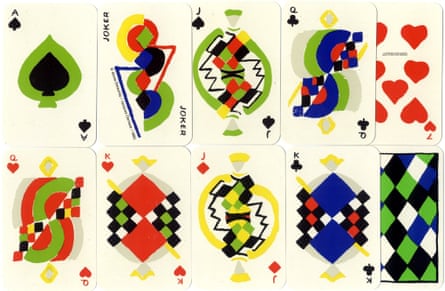
Fortunately, Sonia lived long. By the time of her death in 1979, a new women’s movement was under way and her vibrant contribution to modern art, a counterpoint to a miserable century, was being recognised. Perhaps she was even seen as a safe bet: President Pompidou made a gift of her painting Rythmes-Couleurs no 1633 to President Nixon during an official visit. She remained modern to the last; even late in life, she associated herself with the new and exciting. A snazzy car, a Matra 530, was decorated by her in 1967, when she was 82. The curved lines of the car are painted in large race-flag checks of sky-blue and royal blue, sage green and red. It is art in motion. Sonia ensured that at speed, the colours merged to blue, so as not to distract other drivers.
Among her last works are paintings and etchings, which hark back both in technique and style to the early years of her career. She was by then a French national treasure, but the young Russian who had arrived in Paris full of vigour was still in evidence. A shape or rhythm explored in the 1920s could manifest itself again in the 60s. Is that to say her work didn’t change, didn’t develop? Perhaps she had a different idea of time, more like a spiral than an arrow. A piece called Rhythme sans fin, danse, made in 1964, is subtitled “After a watercolour of 1923”. The clue is in the name; the dance goes on. Colour is joy. Abstraction denies history. As Sonia herself said: “Abstract art is only important if it is the endless rhythm where the very ancient and the distant future meet.”
- Sonia Delaunay is at Tate Modern, London SE1, from 15 April to 9 August. tate.org.uk. Kathleen Jamie’s books include Sightlines.
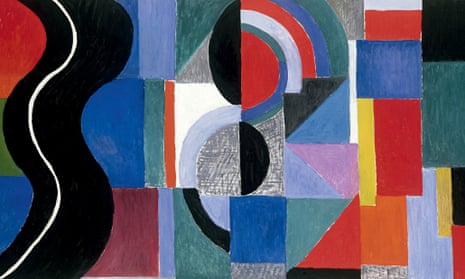
Comments (…)
Sign in or create your Guardian account to join the discussion